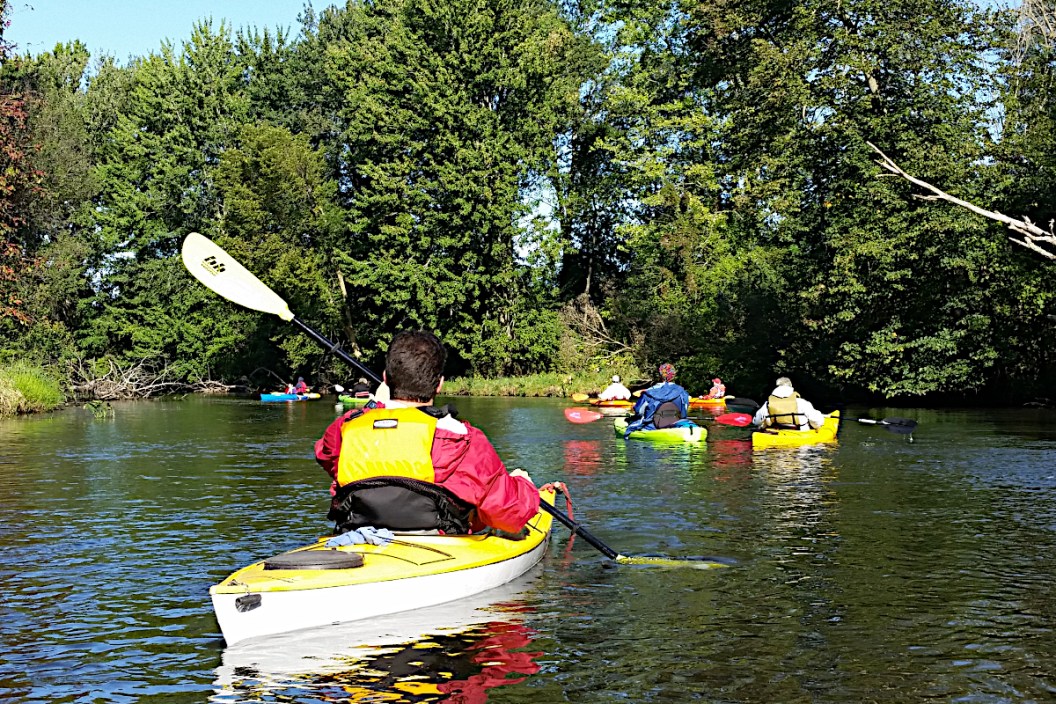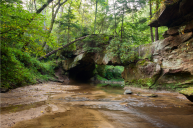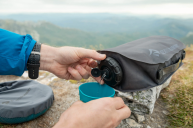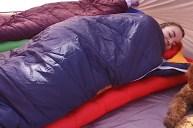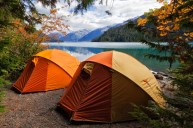Here's what you need to know for a kayak camping trip.
Kayaking is a great way to spend a day on the water during the summer months. But you know what's better? A kayak camping trip! An overnight kayak paddling trip is much different than just a day trip down the river, but a little preparation makes the experience an unforgettable one.
It sounds intimidating at first, but no worries, it's sort of like a backpacking trip. Only on water. We want to make your first time taking camping gear out in your kayak into a camping experience you'll remember for years to come.
It doesn't matter if you're just doing a short overnight trip a multi-day whitewater kayak or canoeing adventure, these tips should help you out.
Safety first
Packing is the hardest part of any kayak trip. Camping in a kayak isn't like car camping where you can just throw a bunch of gear in the vehicle and go. But we're getting ahead of ourselves a little here. Let's start with some safety gear you should have standard.
- First Aid Kit
- Water filter purification system
- Rain jacket/gear
- Fire starter/waterproof matches
- GPS unit/locater
- Duct tape (for your repair kit!)
- Signal mirror or flare (for alerting rescuers if you get stranded.)
You might find all these items useful around camp. But their value goes up substantially in an emergency. Things happen, people get lost or stranded on kayak trips. Paddlers need to be very cognizant of what camping equipment they are bringing aboard.
The ability to deal with injuries, drink fresh water and build fires could all be life-saving. A GPS unit can help you find your way out if you're lost. If you're going on an especially remote trip where cell service will likely be lost, a locator unit like the Spot X allows you to stay in contact with loved ones and call for help if you need it.
Oh, and don't forget life jackets. If someone in your group doesn't have one, don't leave until they do.
About a year ago some friends and I had a seriously scary day trip paddling experience in cold water that forever changed how I look at any kayaking trip. It's no joke; no matter how experienced you think you are, bring a life jacket.
Other standard gear
When it comes to the rest of your kayak camping gear, the size of your boat obviously affects how much gear you can bring. A touring kayak or sea kayak with multiple storage areas is obviously going to be better on long trips than a simple 10-foot kayak or inflatable craft made for open water paddles on small lakes or streams. The best kayaks for camping will be a bit overboard on the storage options.
Kayak campers should pay close attention to the weight capacity of their craft before you put in at the launch. You might not think about how much space your gear takes up until you're loading it on the kayak for the first trip.
Even better. Do a dry run first. Practice loading your gear in the kayak in your garage or yard. You don't want to get to the launch only to find there is no room for your sleeping pad and tent in the kayak! You also want to make sure the kayak is not too heavy to easily portage if you must go around an obstacle deep in the backcountry.
One of the biggest challenges of a kayaking trip is keeping all your gear dry. A good dry bag will help keep your tent and sleeping bags dry.
You can buy small dry bags for many of your other smaller items like portable cook stoves, cookware, fuel, clothing, towels, water bottles, trash bags, toilet paper, bug spray, sunscreen, cameras and food. For items like your car keys, wallet, medications and electronics I recommend a plastic box of some kind. Something you can clip to your kayak or will float in case you flip.
I like to keep this somewhere up front where I can access these items quickly if needed. I also like to keep it there just so I can keep an eye on it.
In the past, I have also used metal and plastic ammo cans to store gear in my kayak. They add a little bit of weight, but a metal can has a nice gasket seal you can trust to keep the contents dry. Plus, unless significantly weighed down, these cans float, making it easy to recover them after a flip.
Another important piece of gear for kayakers is some kind of cutting tool. I've carried a machete on my kayak in the past. It is one of those multi-purpose ones with a saw blade on the opposite site, but you can use a folding saw too. A hatchet works too.
Whatever you choose, make sure you can access it while paddling for clearing away small downed trees that may be obstructing your passage down the river. Especially while wearing a PFD device. You'll likely also find it useful for a variety of tasks around camp in the evenings.
Also, do not forget the all important "leave no trace" principles. You are likely going to be far into the wilderness in some State Park or National Park. Garbage cans are probably not going to be accessible. Everything you bring in, you will have to pack out with you.
Watch the weight distribution!
You may be very familiar with your kayak, but when you add 30-50 pounds of camping gear to it, it may handle a little differently than usual.
I don't recommend launching in the fastest-flowing section of the river if you can avoid it. Ideally, there will be a flatwater area with little current where you can get used to how much lower your kayak will likely sit in the water. Know your skill level ahead of your trip and make sure not to exceed it. This is one of the most important kayak camping tips I can give you.
If you find the kayak is harder to maneuver, you may have to make some adjustments. Try to distribute an equal amount of weight in both the bow and stern for best results. This may be easy if your kayak comes with a lot of cargo hatches, or it may be difficult if you're simply stuffing stuff behind your seat and foot pegs.
Try to make the back load slightly heavier than the front. A front-weighted kayak is much harder to steer. Trust me, I know this from experience.
If you're strapping a small cooler to your kayak, make sure it doesn't throw off your balance significantly. There are specialty "kayak coolers" on the market that can be towed behind your craft if you need a lot of space for food and drinks.
Whatever you do, don't set off until you're comfortable with how the kayak is handling. It's a safety thing, especially if you encounter any unexpected fast water or run into an underwater obstruction like a downed tree.
The packing is the hardest part
Packing for a kayak or canoe camping trip like this is really the hardest part. You'll likely spend some time prioritizing what you need and what you don't need. You may find you need to buy some new equipment if some items, such as camp stoves, are too heavy. Don't skimp on doing your homework ahead of time, it'll make for a much better trip.
With some careful planning and some good equipment you'll also find it to be one of the most enjoyable get away camping experiences out there!
For more outdoor content from Travis Smola, be sure to follow him on Twitter and check out his Geocaching and Outdoors with Travis YouTube channels.
NEXT: HOW A CLOSE CALL REMINDED ME ABOUT LIFE JACKET IMPORTANCE
WATCH: EXCLUSIVE LOOK AT THE BRAND NEW GERBER FASTBALL
